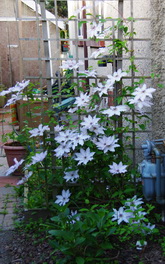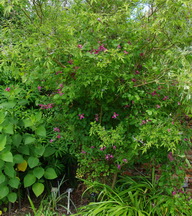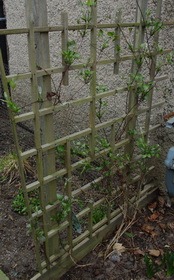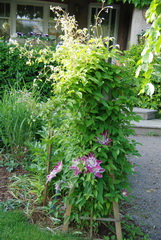|
Clematis
|

Where To Plant Them? They do their best in a bright sunny location with a sturdy trellis or small tree to climb on. They climb by means of tendrils that grow out from the nodes and wrap themselves around the supports. The lattice in the trellis must be small enough to allow the tendrils to hang on. When attempting to grow them through a tree, a delightful presentation, a bit more work is involved, training them and tying them to the tree until they get mature enough to stay wrapped around the tree’s branches. Then there is the bit about having the roots in the shade. That’s actually not that difficult for a tall vine. Just plant a small evergreen shrub or bushy perennial in front of the Clematis and the job is done.
 Three Blooming Times? The two large flowering types will start this year’s growth from somewhere along their woody stems from last year. One group blooms in late spring / early summer while another similar group waits until mid summer to display its splendour. These two groups are quite similar in growth and flowering but their flowering times vary by variety. The third group includes a few species Clematis and some of their hybrids. These grow very rapidly from their roots every year and have a multitude of smaller flowers in late summer. Some of these Clematis have seeds pods that are as attractive as the flowers.
Three Blooming Times? The two large flowering types will start this year’s growth from somewhere along their woody stems from last year. One group blooms in late spring / early summer while another similar group waits until mid summer to display its splendour. These two groups are quite similar in growth and flowering but their flowering times vary by variety. The third group includes a few species Clematis and some of their hybrids. These grow very rapidly from their roots every year and have a multitude of smaller flowers in late summer. Some of these Clematis have seeds pods that are as attractive as the flowers.

How To Prune? In our part of the world, we essentially let the vine tell us what to do. New growth will appear at several points along the thin woody vines of the large flowered varieties. Simply prune off the dead vines and let the new growth carry on. If the vine has become too large for its support then simply prune the vine down to a shoot of new growth that reduces the plants overall size to something that fits the trellis. Some years even these types will die to the ground and start all of this year’s growth from there. The smaller flowered types are typically pruned to the ground each year. Usually last year’s stems do not survive the winter. They have significant roots which produce rapid new growth.

Transplanting? Many of us find that our original choice of location for a new plant turns out not to be the best location for it. I have moved one year old vine and a much older one with apparent success. Realize that they develop significant root systems in just a few years. This necessitates the digging of a substantial root ball if you are moving an established plant. A large root ball will reduce the number of small feeder roots that are disturbed and greatly improve the chances of success.
There are few vines that have such a large colourful presence in the garden while remaining relatively small in size. Every gardener who wants to get some coloured interest up higher in their landscape or who has ugly walls to cover should have a few different varieties of Clematis.
You can search my entire site for answers to your gardening questions or sign up below for my free ezine.
